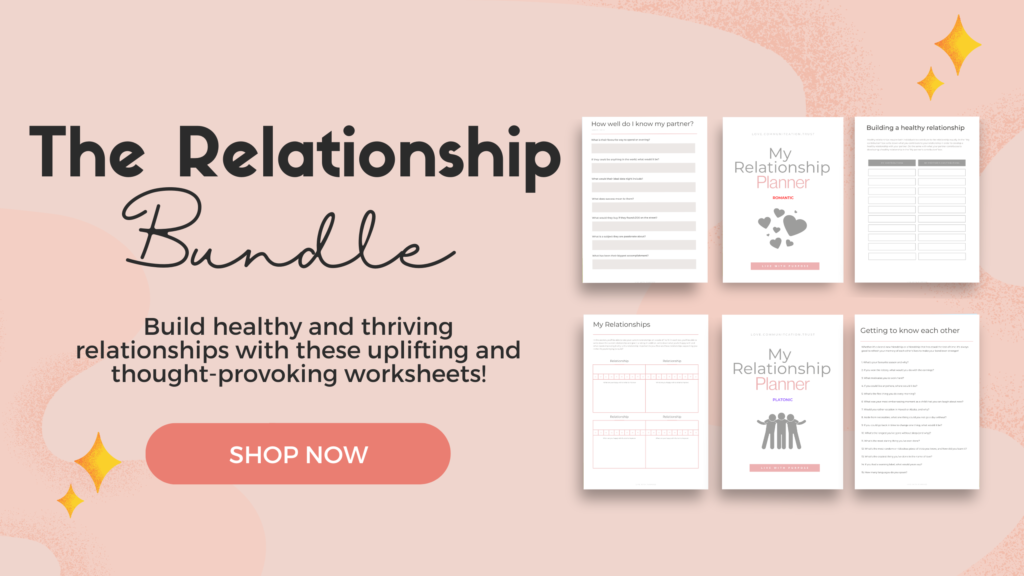
In a world that often emphasises the value of social connections, there’s an important distinction to be made between being alone and feeling lonely.
Many people associate solitude with a sense of isolation or sadness, but the truth is that being alone can be a fulfilling and rejuvenating experience. 😊
In this blog post, I will explore the nuances of being alone versus feeling lonely, understanding the importance of solitude, and embracing the positive aspects of both states.
Let’s get to it. 💕
The Difference Between Being Alone and Feeling Lonely:
Being Alone:
Being alone is a state of physical solitude, where you find yourself without the company of others. It can occur by choice or as a natural consequence of circumstances. Spending time alone provides an opportunity for self-reflection, relaxation, and personal growth.
It allows you to engage in activities that bring you joy, pursue hobbies, or simply enjoy a moment of peace. Being alone can be a deliberate choice, a time to recharge and connect with oneself. 🥰
Feeling Lonely:
Loneliness, on the other hand, is an emotional state that arises from a perceived lack of meaningful connections. It’s possible to feel lonely even in a crowded room if the connections are superficial or unfulfilling.
Loneliness is often characterised by a sense of emptiness, isolation, or a longing for deeper human connections. It’s a complex emotional experience that can impact mental and physical well-being. 😟

Embracing the Positive Aspects of Being Alone:
1. Self-Discovery:
Being alone provides an opportunity for self-discovery. It allows you to explore your thoughts, feelings, and interests without external influences. Use this time to reflect on your goals, values, and aspirations. Self-discovery is a crucial aspect of personal growth and can lead to a deeper understanding of oneself.
2. Independence:
Embracing solitude fosters independence. When you’re comfortable being alone, you become more self-reliant and less reliant on others for your happiness. This independence can empower you to make decisions based on your own needs and preferences, leading to a more authentic and fulfilling life. 🥰
3. Creativity:
Solitude often sparks creativity. When you’re alone with your thoughts, you have the mental space to generate new ideas, think critically, and engage in creative pursuits (yaay). Many artists, writers, and innovators find inspiration in moments of solitude, leading to the creation of meaningful and impactful work. 🎨
4. Rest and Rejuvenation:
Being alone allows for rest and rejuvenation. In a world filled with constant stimuli, taking time for solitude can be a form of self-care. It provides an opportunity to relax, recharge, and focus on activities that bring you peace and joy, contributing to overall well-being.

Addressing the Challenges of Feeling Lonely:
1. Cultivating Meaningful Connections:
If loneliness arises from a lack of meaningful connections, focus on cultivating relationships that nourish your soul. Seek out individuals who share your values and interests. Join clubs, organisations, or communities where you can meet like-minded people. Focus on getting yourself out there. Quality connections are often more fulfilling than a large social circle. 🫂
2. Volunteering and Giving Back:
Engaging in volunteer work or contributing to your community can alleviate feelings of loneliness. By helping others, you not only make a positive impact on the world but also connect with individuals who share a common purpose. Volunteering provides a sense of belonging and fulfillment.
3. Seeking Professional Support:
If loneliness becomes a persistent and overwhelming emotion, maybe consider seeking professional support. A therapist or counselor can provide guidance and a safe space to explore the root causes of loneliness. Addressing these issues with professional help can lead to a more fulfilling and connected life. 🫶
Finding Balance:
The key to a fulfilling life lies in finding a balance between being alone and fostering meaningful connections. Embrace solitude as a time for self-discovery, creativity, and rejuvenation. At the same time, actively cultivate relationships that bring joy and fulfillment. Recognise that both states are essential for a well-rounded and satisfying life. 💕
Conclusion
Being alone and feeling lonely are two distinct experiences, each with its own set of opportunities and challenges. Embracing solitude allows for self-discovery, independence, creativity, and rest. However, if loneliness creeps in, it’s crucial to address it by cultivating meaningful connections, volunteering, or seeking professional support. You are not alone. ❤️
Understanding the nuances between being alone and feeling lonely empowers you to navigate both states with intention and purpose. Ultimately, finding a balance between solitude and social connections contributes to a rich and fulfilling life. Embrace the positive aspects of being alone, foster meaningful connections, and savor the journey of self-discovery in this beautiful dance between solitude and companionship.
Pin this post for a reminder 📌 👇

Related Blogs
Things to Say “No” to for you to Live a Happier Life
How to Stop Settling For Less Than You Deserve
How to Become the Best Version of Yourself: A Guide For 20-Somethings
What are you scared of? 🤔
We are born with two innate fears: The fear of falling and the fear of loud noises. Both these fears are an instinct necessary for survival.
So! Let’s get started on how to overcome your fear and live your best life.
Storytime!
I personally have a fear of crossing bridges where I can see what’s under me e.g. passing cars, rivers etc. I believe this relates to the innate fear of falling. As my main thought is “omg what if this bridge collapses”. 😬
This fear used to be so bad that I would purposefully take the longest route to avoid going on a bridge or even worse, not go to the location at all if the only option was to get on a bridge.
As you could imagine having a fear like that is totally annoying. It wasn’t until I went to Spain with my sister that my fear subsided.
One day we decided to go to the beach, and to get there we needed to cross this long, thin bridge above a very busy road.
The beach was just on the opposite end of the bridge, all I had to do was just cross it to get there. However I looked at it and thought “ nope, can’t do it. Too long, too thin, no way”.

To be honest with you I don’t even know if I could call this thing a bridge, it was practically a piece of sheet metal.
Nevertheless, I knew my sister was eager to get to the beach and relax in the sun and I didn’t want to get in the way of her enjoying the holiday. She gave me a pep talk and off I went following behind her on the bridge.
I walked as briskly as the sound of cars driving by and horn honking was making my anxiety go through the roof, my heart was pounding out of my chest and my legs were starting to go numb.
I looked down and to my surprise noticed something which made me scream “ OMG THERE ARE BULLET HOLES IN THIS BRIDGE I WANT TO GET OFF” to which my sister replied “Heather shut up it’s not bullet holes” we then argued back and forth over this rackety bridge regarding how these holes got there which completely distracted me to the fact that I was conquering my fear.
Once I stepped off, I felt extremely proud of myself and realised I can conquer any fear if I just “do it”. Sometimes it does take that helping hand of someone pushing you to help you realise your potential, especially if they’re able to help distract you while you’re doing it! 😂
I was prepared to put my fear of crossing the bridge aside as my fear of disappointing my sister was much greater.

^ No, this is not what the bridge looked like but it might as well have!
Heather’s top tip: Surround yourself with people who will push you to overcome the fears holding you back from where you want to go and what you want to do.
Learned fears – Scared of the unknown
The most common fears we experience that sabotage our hope for success is the fear of failure, poverty and loss of money.
These fears cause us to avoid risk and reject opportunity when it is presented. We often spend years chasing opportunity and get comfortable with the chase, so comfortable that it becomes part of our identity.
When the opportunity is within our grasp we freak out and get scared. 😬
This is because of the potential changes the opportunity may bring. If you don’t deal with uncertainty well you’ll most likely create excuses as to why it’s not the right time for you to pursue the opportunity.
Here are a few techniques and tips to help you overcome your fears so you can become limitless
The law of reversibility
The law of reversibility says that “If you feel a certain way, you will act in a manner consistent with that feeling”.
So even if you don’t feel like it but act in a manner consistent with that feeling, the law of reversibility will create the feeling that is consistent with your actions.
This is one of the greatest breakthroughs in success psychology. You develop the courage you desire by disciplining yourself to repeatedly do what you fear until that fear eventually disappears.

Every opportunity can be undone
When an opportunity scares us it’s usually because we fear we’ll make a mistake that can ultimately mess up your career, your personal work or just your life in general.
Nonetheless, the majority of opportunities that can come your way will not be life or death decisions. 🤷♀️
If an opportunity doesn’t work out, it’s not the end of the world. All it is a minor setback and a learning experience to which you can get back up, dust yourself off and carry on working towards your goal.
Opportunities pursued can just as easily be undone. Yet opportunities avoided are difficult to rediscover.
Is it a fear of failure or a fear of success?
You’re probably thinking “Huh!? Why would I fear success?” but the reality is that success changes our lives more than failure and that thought can be really scary, especially when we’ve spent years becoming comfortable with the current way we live.
To clarify whether it’s a fear of failure or a fear of success you need to know your definitions for both.
Related: QUIZ: What does success mean to you?
Fear of failure often involves self-talk such as: “If I don’t try, I can’t fail” There is safety in standing still, not taking on new challenges or trying new things, all of these things can ultimately lead to “failure”.
Success for someone may be a salary of 500k and someone else may define success as a strong and happy marriage.
What is your definition of success?
What is your definition of failure?

Confront your fears immediately
When you identify fear and discipline yourself to move toward it and confront it, it grows smaller and more manageable.
The natural tendency of many people is to deny that they have a problem caused by fear of some kind. They’re afraid of confronting it which results in major stress, unhappiness and psychosomatic illness.
When you force to tackle your fear head on your self-esteem goes up, your self-respect increases and your sense of personal pride grows. 😁
RELATED: Getting out of your comfort zone mini-course

In Summary…
Fear immobilizes and prevents us from achieving what we desire and what we are capable of. Don’t let fear kill your hustle before you even get started.
Understand your fear and embrace it. Fear exists to keep us safe, it is not inherently bad or good but a tool we can use to make better decisions in life.
These tips are my top ways on how to overcome your fear and get what you want!
What methods have you used successfully to overcome your fears? Let me know in the comments 🙂
Pin this post for a reminder 📌 👇

Related Blogs
The ultimate guide for coping with change
Did you know that people on my email list sometimes get exclusive discounts on my products? Join the community and save yourself some coins!
Freshly-squeezed inspiration, and no-nonsense tips + tricks to improve your life delivered to your inbox weekly.
Subscribe to my newsletter
Subscribe
You're all signed up!
Be sure to whitelist our email address so that all the goodies make it to your inbox.
